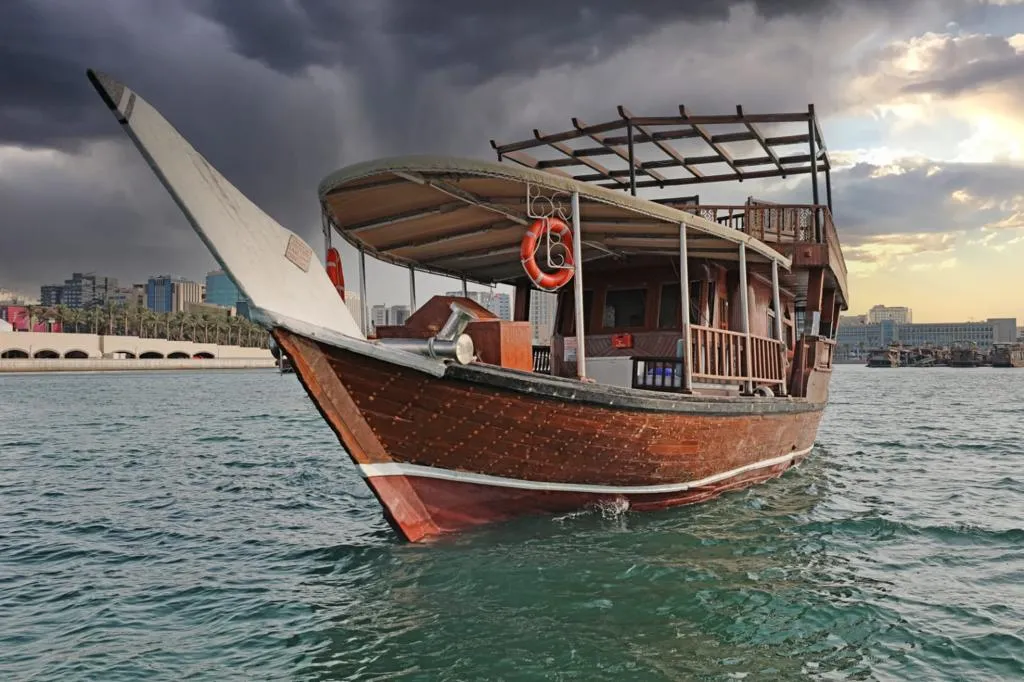Commandité
Discover the Timeless Charm of the Traditional Dhow in Qatar

Qatar, a land rich in culture and history, is deeply intertwined with the Arabian Gulf’s seafaring traditions. Among the most enduring symbols of Qatar’s maritime heritage is the Traditional Dhow Qatar a handcrafted wooden boat that has been central to the country’s trade, fishing, and pearling industries for centuries. Despite the rapid modernization of the country, the dhow remains a powerful symbol of Qatar’s connection to the sea and is celebrated in festivals, cultural exhibitions, and tourism experiences.
This article will take you through the significance of the traditional dhow in Qatar’s history, its role in the modern tourism industry, and why a dhow cruise should be a must-do activity for anyone visiting Qatar.
1. The Historical Significance of the Traditional Dhow
The traditional dhow is more than just a boat; it is a symbol of Qatar’s past and the foundation upon which its modern economy was built. These vessels were first introduced to the Arabian Peninsula thousands of years ago and became essential to the region’s maritime trade routes. Dhows are typically made from sturdy timber, such as teak wood, with triangular sails known as lateen sails that allow the boat to catch the wind from various angles. This made the dhow a versatile and reliable vessel for long sea journeys.
a) Dhows and the Pearling Industry
Qatar’s pre-oil economy was heavily dependent on the sea, particularly on the pearling industry. In the 18th and 19th centuries, pearling was the backbone of Qatar’s economy, and dhows were the vessels that carried divers to the pearling beds scattered throughout the Gulf. These boats were well-suited for the task: large enough to hold supplies for the divers and crew members, yet nimble enough to navigate shallow waters. A typical pearling dhow would spend months at sea during the pearling season, with divers working tirelessly to collect the precious oysters from the seabed.
During this time, the Qatari dhow was not just a vehicle for economic activity; it was also a home for the crew. The sailors and pearl divers formed tight-knit communities aboard the dhows, living together in close quarters, facing the dangers of the sea and the uncertainties of each dive. Pearling was a hard, dangerous, and sometimes deadly occupation, but it was the dhow that made it possible.
b) Fishing and Trade
In addition to pearling, dhows were essential for fishing, which provided a steady source of food for local communities, and for trade. Traders used these boats to transport goods such as dates, spices, textiles, and other commodities across the Gulf, to places like India, East Africa, and beyond. The dhow’s design allowed for significant cargo space, making it the ideal vessel for long-distance trade.
2. The Craftsmanship Behind the Traditional Dhow
Building a traditional dhow requires exceptional skill and craftsmanship, a tradition that has been passed down through generations of Qatari boat builders. The construction process is entirely manual, with each piece of wood carefully shaped and fitted by hand. The materials used to build dhows were traditionally imported, with timber sourced from India or East Africa. The wood is treated with natural oils to protect it from the saltwater, ensuring that the boat can withstand the harsh marine environment.
Each dhow is built with a specific purpose in mind. There are several types of dhows, each serving different functions:
Sambuq: A larger dhow, often used for pearling or cargo transport.
Jalibut: A medium-sized dhow commonly used for fishing.
Boum: Known for its deep hull, this dhow was traditionally used for long-distance trade.
The dhow’s unique curved shape, with its high stern and pointed bow, is both aesthetically striking and functional. The design allows the dhow to cut through the waves efficiently, making it ideal for the often-turbulent waters of the Arabian Gulf.
3. The Dhow in Modern Qatar: A Blend of Tradition and Tourism
As Qatar rapidly modernized in the 20th century with the discovery of oil, the traditional dhow became less of a necessity for fishing and trade. However, rather than disappearing, the dhow has evolved into a symbol of national pride and a key part of Qatar’s tourism and cultural offerings.
a) Dhow Cruises Along the Doha Corniche
One of the most popular ways to experience the beauty of the traditional dhow in modern Qatar is through a dhow cruise along the Doha Corniche. The Corniche, a waterfront promenade that stretches for seven kilometers along Doha Bay, offers stunning views of the city’s skyline. Tourists can board a traditional wooden dhow and sail along the calm waters of the Arabian Gulf, with the towering skyscrapers of West Bay on one side and the tranquil sea on the other.
Dhow cruises offer a variety of experiences, from daytime sightseeing trips to sunset cruises, and even evening dinner cruises where guests can enjoy traditional Qatari cuisine under the stars. Many of these cruises are enhanced with entertainment, such as traditional music, belly dancing, or live performances, giving visitors a deeper connection to Qatari culture.
b) Cultural Celebrations and Festivals
Qatar is committed to preserving its maritime heritage, and the dhow plays a central role in many cultural celebrations. The Katara Traditional Dhow Festival, held annually at the Katara Cultural Village, is a celebration of the dhow and its importance to Qatari history. The festival features dhow races, exhibitions on dhow building and pearling, and live performances that showcase the cultural significance of the sea to the people of Qatar.
Dhow races are one of the highlights of these festivals. Teams of sailors race their boats across the waters of the Arabian Gulf, demonstrating their skill in navigating and controlling these traditional vessels. The races are a thrilling spectacle and a reminder of the enduring bond between Qatar and the sea.
4. Why a Dhow Experience is a Must for Visitors to Qatar
For travelers looking to experience the authentic side of Qatar, a traditional dhow cruise is an essential activity. It offers a unique perspective on the country’s history and allows visitors to connect with a way of life that has endured for centuries. Whether you’re sailing along the Doha Corniche, exploring the waters around Al Safliya Island, or enjoying a traditional meal aboard a dhow, the experience is both relaxing and culturally enriching.
a) Doha Skyline at Sunset
One of the most breathtaking experiences you can have on a dhow is witnessing the Doha skyline at sunset. As the sun sets over the Arabian Gulf, the city’s skyscrapers are bathed in golden light, creating a stunning backdrop for your journey. The peaceful atmosphere of the dhow cruise, combined with the beauty of the skyline, makes for an unforgettable evening.
b) Private and Customized Dhow Tours
For those looking for a more personalized experience, many tour operators in Qatar offer private dhow charters. These private tours can be customized to suit your preferences, whether you want to explore secluded beaches, go on a fishing expedition, or celebrate a special occasion with friends and family. Private dhow charters are perfect for those who want to enjoy a more intimate and exclusive experience of Qatar’s coastline.
c) Traditional Qatari Hospitality
A dhow cruise also provides an opportunity to experience traditional Qatari hospitality. Many tours offer onboard refreshments, such as Arabic coffee and dates, along with meals that feature local dishes like grilled fish, lamb, and a variety of mezze. The crew members are often happy to share stories about Qatar’s seafaring past, giving you a deeper appreciation for the culture and history of the region.
5. The Legacy of the Traditional Dhow in Qatar
While the traditional dhow may no longer be the primary vessel for trade, fishing, or pearling, its legacy continues to be celebrated throughout Qatar. The art of dhow building is still practiced in small workshops, particularly in places like Al Wakrah, where artisans use the same techniques that have been passed down through generations.
The government of Qatar, in partnership with various cultural institutions, has made significant efforts to preserve this maritime heritage. Educational programs, festivals, and exhibitions ensure that the story of the dhow continues to be told to future generations.
For visitors, experiencing a dhow cruise or attending a dhow festival is not just about seeing a beautiful boat—it’s about connecting with the heart of Qatari culture, understanding its history, and appreciating the skill and craftsmanship that have shaped the country’s relationship with the sea.
Conclusion
The traditional dhow is a timeless symbol of Qatar’s connection to the sea, a vessel that has carried the country through centuries of trade, pearling, and fishing. Today, it remains a vital part of Qatar’s cultural heritage, offering visitors a unique opportunity to experience the country’s history firsthand. Whether you’re enjoying a sunset cruise along the Doha Corniche, participating in a dhow race at the Katara Festival, or simply admiring the craftsmanship of these wooden boats, the traditional dhow is a must-see for anyone looking to explore the authentic side of Qatar.




